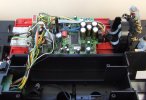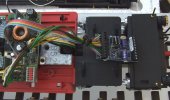Am getting back into this hobby after many years away and am stumped right now. I just acquired an LGB 70685 Orient Express set and am trying to figure out how I can run the Mallet with some new to me LGB items (55005p Central Station, 50111 transformer, 55015p remote, 55016 remote).
When I set a remote to L 0, I can control the direction and speed of the loco. If I set the remote to another address like L 1, it doesn’t respond. Doesn’t this indicate that this 21852 Mallet has a decoder of some sort?
In doing some research, I believe that this set predates MTS? The sticker on the box mentions “Sound” and DC 0-24V but nothing about MTS. And the “OK” sticker on the bottom indicates that the Mallet was built in June of 1997. I’m guessing that a previous owner added a decoder and will look inside once I figure out how to open it up.
When I set a remote to L 0, I can control the direction and speed of the loco. If I set the remote to another address like L 1, it doesn’t respond. Doesn’t this indicate that this 21852 Mallet has a decoder of some sort?
In doing some research, I believe that this set predates MTS? The sticker on the box mentions “Sound” and DC 0-24V but nothing about MTS. And the “OK” sticker on the bottom indicates that the Mallet was built in June of 1997. I’m guessing that a previous owner added a decoder and will look inside once I figure out how to open it up.


